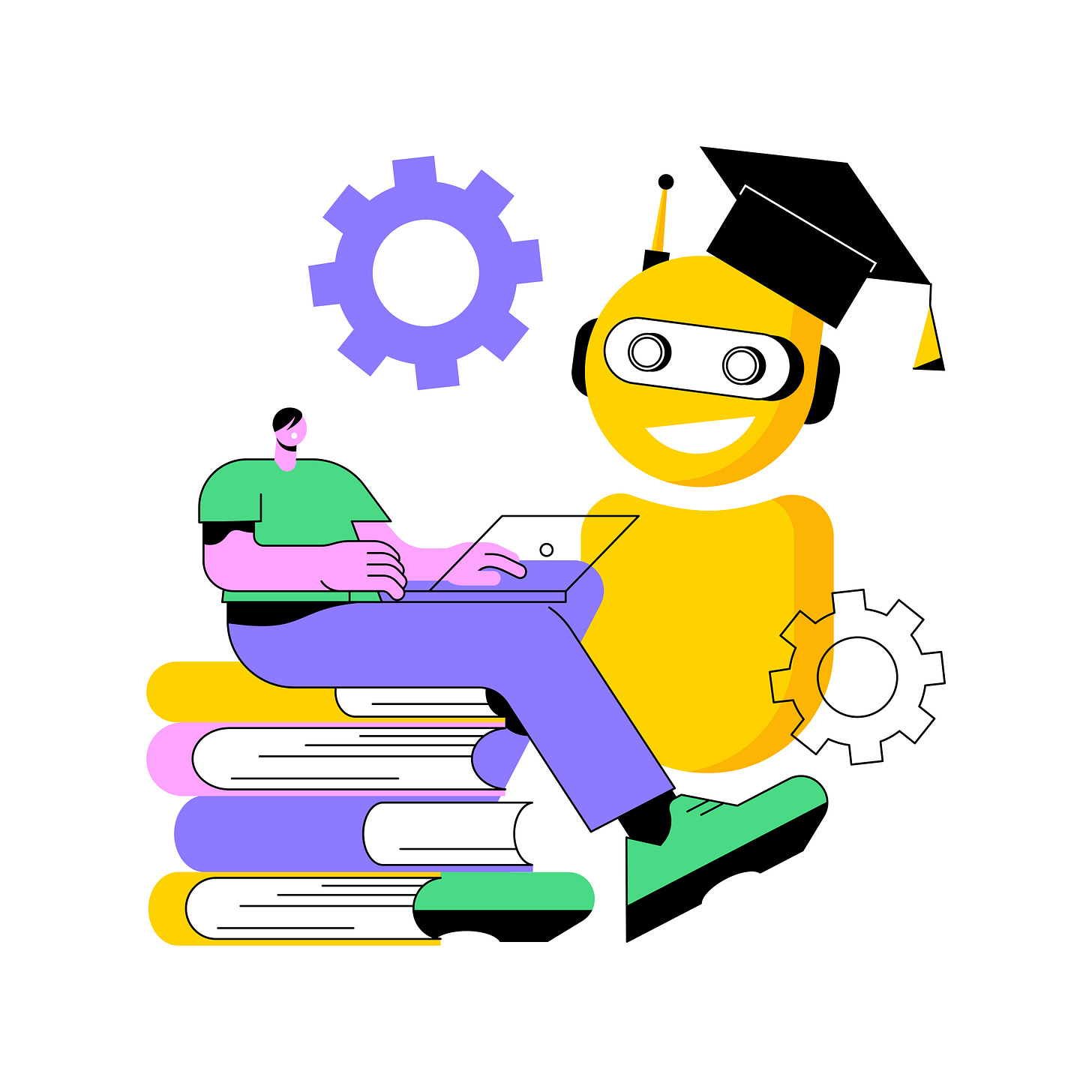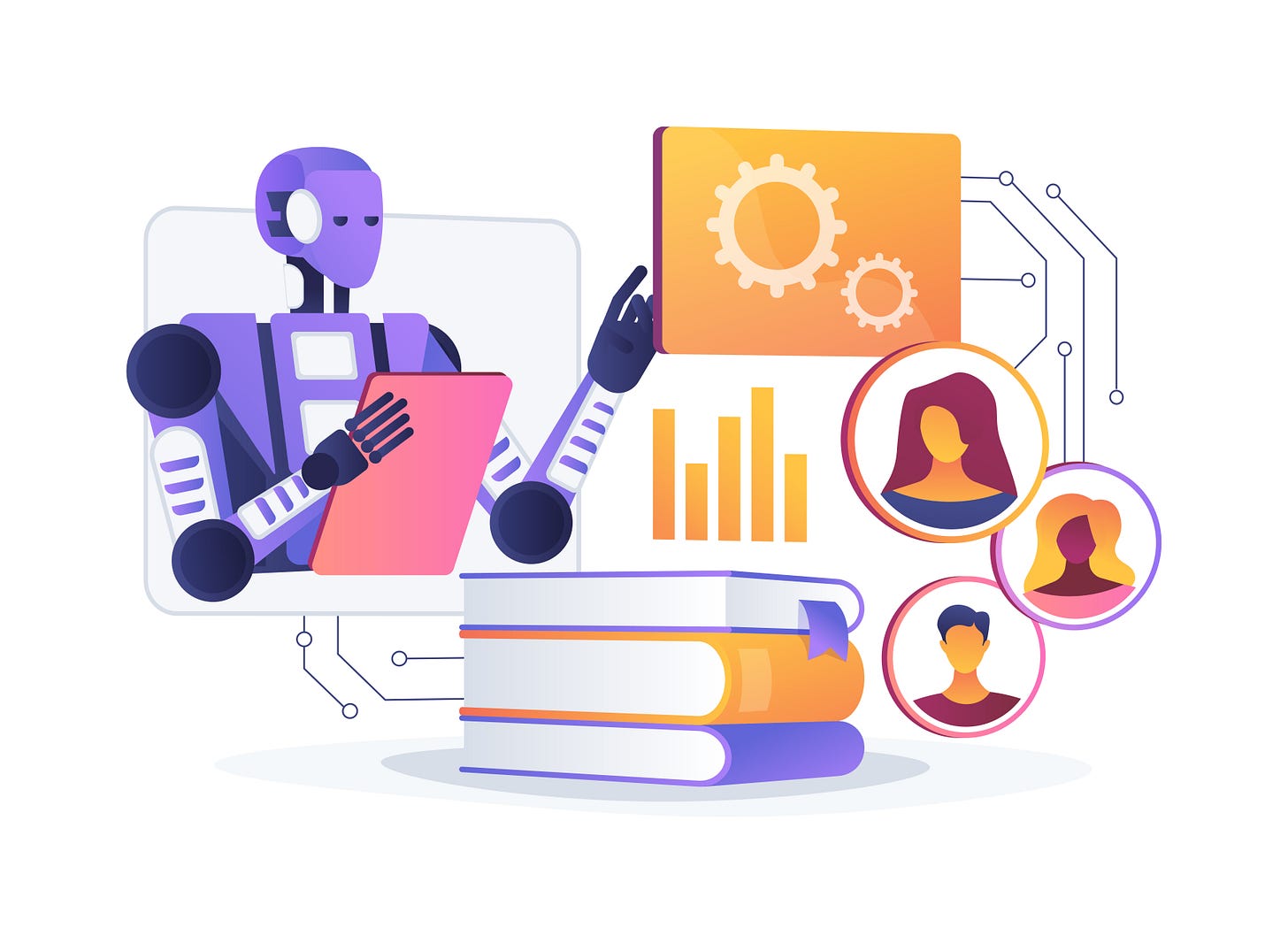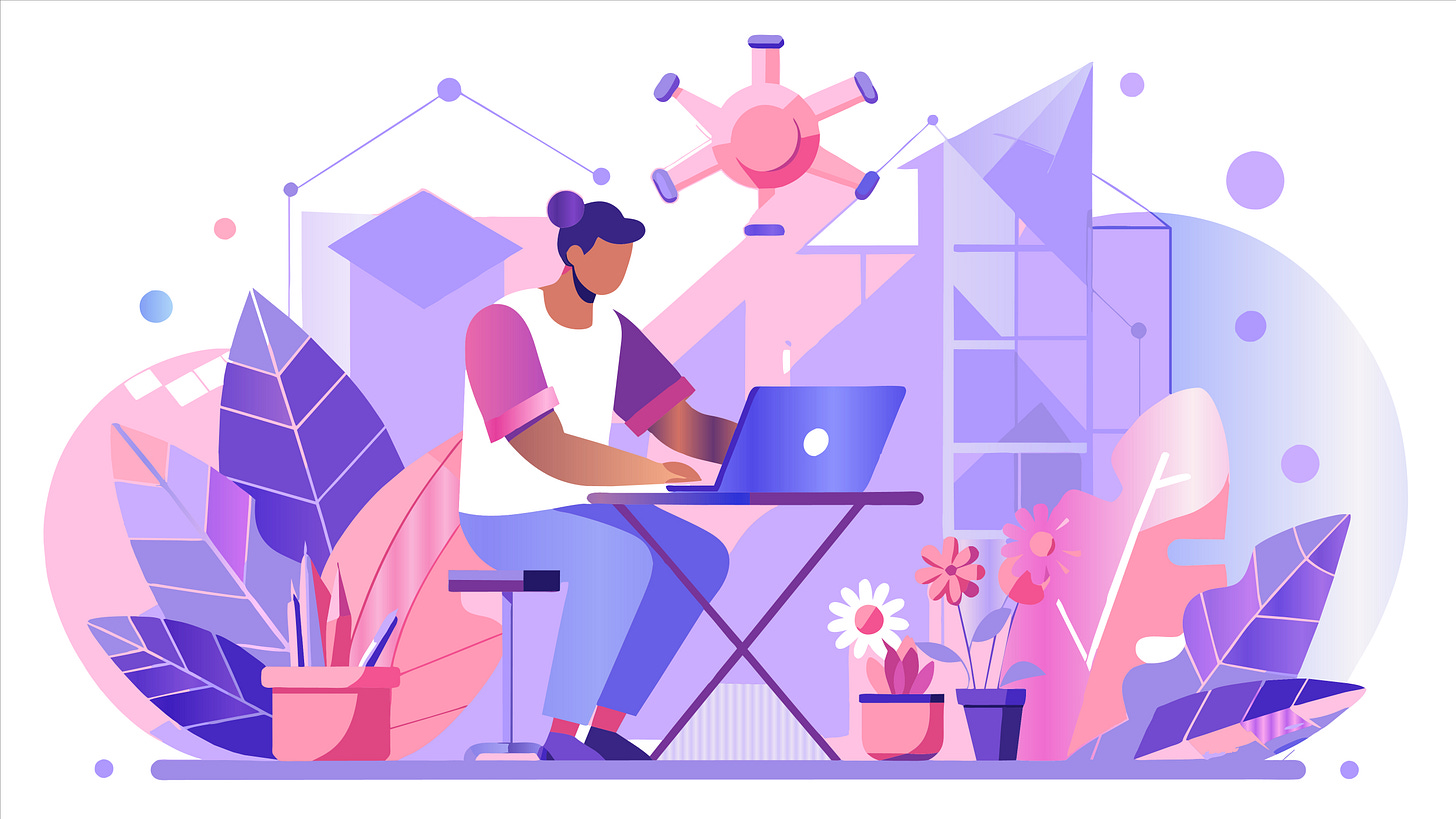Learning with AI: A Beginner’s Guide to Using ChatGPT for Smarter Learning
5 Easy Strategies to Build Skills, Sharpen Thinking, and Stay Curious in the Age of AI
I’ve been watching my kids learn in ways that look nothing like how I did growing up. Surrounded by AI, they ask questions, explore ideas, and get help from tools that didn’t even exist when I was their age.
And honestly? That’s not a bad thing.
I don’t think learning has gone downhill. If it had, we wouldn’t keep moving forward in science, tech, and education. Learning evolves. It changes with the tools we use.
And right now, AI is the biggest shift we’ve seen since the internet became a household utility.
I still remember the public freakout when the internet went mainstream. People worried we’d stop thinking critically because we could just “Google it.”
But we didn’t lose our thinking skills—we just learned to use them differently. The folks who figured out how to think critically with the internet thrived.
It’s the same story all over again—just playing out on a bigger stage.
That’s actually why I started the Ay-I Guy - to help regular people figure out how to thrive in this next big shift.
If we’re not careful, we can slip into habits that feel smart—but don’t actually make us smarter.
This article is about how to use AI in ways that support and strengthen your learning—whether you’re picking up a new skill, helping your kids with homework, or just trying to keep up in a world that’s moving fast.
These aren’t theories or hype. They’re practical strategies—grounded in research and real experience.
And they’re designed to help you keep your brain sharp while still making the most of what AI can do.
In the sections that follow, I’ll walk you through five smart ways to use AI that actually support your learning—not just speed it up. These tips are all about keeping your brain sharp, your curiosity sparked, and your skills growing.
Treat AI as a Learning Helper, Not an Answer Machine
When you’re learning something new, how you use AI matters as much as what you’re learning.
It’s tempting to treat it like a shortcut machine: ask a question, get a neatly packaged answer, move on.
But using AI passively short-circuits the learning process. It’s like copying off someone else’s test: sure, you get the answer—but you didn’t actually learn anything.
Worse, you’re setting yourself up to fail the moment the AI misunderstands the question—or invents an answer because it thinks you’re writing a fantasy story instead of solving a real problem.
If you’re not doing the thinking yourself, you’ll miss those moments when things don’t add up.
AI is way more useful when you treat it like a learning helper—not the person doing your homework, but the one who sits next to you and talks through the hard stuff.
Ask it to explain concepts, compare ideas, reframe questions, or help test your understanding. That kind of interaction keeps your brain engaged while still giving you support.
And this isn’t just a feel-good suggestion—there’s solid research behind it.
One study on students learning to code found that those who used AI to explore ideas and ask questions made real progress. But students who just used it to crank out answers? Not so much.
Instead of asking “What’s the answer to this problem?” try:
“Can you walk me through how to solve this?”
“What’s a different way to think about this concept?”
I’ve had times where I was just looking for a quick explanation and wound up with a better understanding—because I stayed curious and kept digging. That’s the goal: use the AI to help you learn, not just to finish the assignment.
Avoid Mental Shortcuts—Think Before Accepting AI's Answer
One of the easiest traps when using AI is assuming that if it sounds confident, it must be right.
The problem? AI is often confident even when it’s completely wrong.
If we take its output at face value without engaging our own brains, we’re not just missing a learning opportunity—we’re outsourcing the thinking entirely.
Researchers call this “cognitive offloading”—basically, letting a tool do the thinking we should be doing ourselves.
In everyday life, that kind of offloading is totally fine. Using a calendar instead of your memory, or GPS instead of your sense of direction? That’s just smart.
But when it comes to learning or problem-solving, offloading too much can weaken the very skills we’re trying to build.
In one study, people who had high confidence in AI tools were less likely to engage in critical thinking while using them.
Meanwhile, those who trusted their own knowledge more were quicker to verify, cross-check, and reason through what the AI said.
The takeaway? If you trust the tool too much, you stop thinking.
It’s not that AI can’t be trusted—it just shouldn’t go unchallenged. That’s how you stay sharp.
The next time AI gives you an answer, don’t stop there. Ask:
“What would someone who disagrees say?”
Or, try explaining the answer in your own words without looking—then ask the AI to critique your explanation.
Did you miss something? Misunderstand a key point?
You can even use a second AI model—or just a different prompt style—to double-check yourself. Some models can now search the web or pull from specialized sources. So you’re not just limited to answers—you can generate ideas, test your understanding, and challenge it until it holds up under scrutiny.
That’s where AI stops being just a tool and starts becoming part of your thinking process. But that only works if you stay in the loop.
Passive use doesn’t just stop growth—it leaves you vulnerable when the AI misunderstands your question or makes something up.
Bottom line: Use AI to make yourself smarter, not just faster. And that starts by staying mentally present—even after the answer shows up on your screen.
Practice Higher-Order Thinking—Go Beyond Passive Consumption
AI can help you learn, but if you’re not careful, it can flatten your thinking.
You’ll get surface-level summaries, bullet points, and just-enough-to-get-by explanations that feel satisfying…
Until you realize you can’t actually apply or transfer what you just read.
That’s why higher-order thinking matters.
It goes beyond remembering and understanding—and pushes into applying, analyzing, evaluating, and creating.
Here’s the cool part: AI can actually accelerate higher-order thinking—if you know how to use it.
You’ve probably heard, “The best way to learn something is to teach it.”
AI gives you a way to simulate that—by letting you talk through ideas, explain concepts in your own words, and get feedback as you go.
After you’ve learned something with AI, flip the script. Try saying:
“I’m going to try to explain this concept back to you. Act like a critical professor and poke holes in my explanation.”
“Can you help me spot any flaws, gaps, or assumptions in my thinking?”
You can even ask the AI to roleplay as someone who disagrees with you—just to see if your understanding holds up under pressure.
This kind of back-and-forth is what separates casual use from transformational learning.
A recent study on generative AI in coding classes found that students who used AI to explore why things worked—and how to approach problems—gained a deeper, more transferable understanding.
They weren’t just memorizing—they were thinking.
Another study found that while AI can boost performance—and even motivation—it’s the quality of the interaction that really matters.
Using AI to engage with complexity—asking for counterexamples, deeper explanations, or opposing perspectives—encouraged higher-order reasoning and helped students retain what they learned.
You don’t need fancy prompts—just curiousity and a willingness to stick with the learning process a little longer.
Ask AI to help you apply a concept in a new context:
“Can we take this same idea and apply it to [a different problem]?”
Or even better: “What would go wrong if someone misunderstood this and applied it the wrong way?”
Embrace Productive Struggle
One of the sneaky dangers of using AI for learning is that it makes things too easy.
And while “easy” sounds great—especially when you’re tired, busy, or overwhelmed—it can actually get in the way of meaningful learning.
Here’s the hard truth: real learning often feels uncomfortable.
It’s the mental version of sore muscles after a good workout.
Wrestling with a problem, sitting with “I don’t get this yet,” and slowly building your understanding—that’s not failure. That’s learning in action.
AI can support that process—if we use it intentionally. But if we’re not careful, it can also short-circuit it.
Educators call this productive struggle—the kind of challenge that leads to lasting understanding.
Skip the hard parts, and the learning doesn’t stick.
But if you engage, reflect, and iterate? That struggle becomes fuel for growth.
When you hit something tricky, resist the urge to ask AI for the final answer.
Instead, try:
“Here’s what I think is going on. Can you help me test that logic?”
“Can you give me a hint without giving away the solution?”
If you’re stuck, ask for a nudge—not a shortcut.
Here’s where things get exciting: AI offers support that didn’t exist before.
The internet gave us access to information, but it didn’t help us make sense of it. We still had to search, compare, and sift through pages of content—often needing some specialized knowledge just to get started.
LLMs shift that dynamic. You can now interact with the information—ask for summaries, analogies, side-by-side comparisons, or step-by-step explanations tailored to your level.
That’s what finally helped me wrap my head around car maintenance after years of bouncing off dense forums and how-to blogs.
Same with computer troubleshooting—I didn’t need a new site; I just needed a way to synthesize what was already out there.
AI gave me that.
It’s a meaningful step forward—not because it gives instant answers, but because it gives us a better way to work with information while staying mentally engaged.
You want some friction. You want to struggle a bit.
That’s how knowledge moves from short-term memory into something more permanent.
And now, thanks to AI, we have a helper that can keep us in the struggle zone just long enough—without leaving us lost.
Use AI to Build Curiosity, Not Just Complete Tasks
AI isn’t just useful—it’s kind of a playground, if you let it be.
Sure, it can help you crank out an email or summarize a dense article.
But where it really gets interesting is when you start using it to follow your curiosity.
Ask a weird question. Explore a tangent. Invent a scenario and see what happens.
That’s not wasted time. That’s where the good stuff starts.
When you chase those little sparks of “wait, what if…” or “why does that happen?” you’re not just grabbing facts—you’re constructing meaning.
That’s what makes learning stick. It becomes personal, memorable, yours.
Here are a few ways to play with curiosity:
Ask it to write a story that weaves in the concept you’re learning.
Better yet—have it sneak in a few wrong facts, then go hunting for them.
Turn what you’re studying into a mini-game, a trivia quiz, or a choose-your-own-adventure.
Or ask for surprising, strange, or overlooked angles on the topic—and see where it takes you.
One of the best parts? You don’t have to know what you’re looking for.
AI is fantastic at meeting you in that fuzzy space between “I’m bored” and “I wonder…”
You can explore in plain language, follow tangents, and even be a little silly—because the learning still happens.
Try stuff like:
“What’s a bizarre but technically accurate metaphor for how mitochondria work?”
“Explain this concept like it’s a 1980s action movie.”
“Create a set of flashcards that get more sarcastic the harder they get.”
When you turn your curiosity loose like this, you stop treating learning as a task—and start experiencing it as discovery.
And that makes it sticky.
You’re more likely to remember what you learn, apply it in different situations, and keep building on it over time.
So yes, check things off your list. But don’t forget to wander. The most useful insights often show up after the “real work” is done—when you’re just playing around.
Learning with AI Still Counts (Give Yourself Credit)
There’s this weird guilt that can creep in when you use AI to help you learn—like maybe it doesn’t “count” because the info came from a machine instead of a book, a teacher, or a traditional study session.
But let’s be clear about something:
If you’re actively thinking, questioning, experimenting, and applying what you learn—then yes, you’re absolutely learning.
The tool doesn’t make the learning less real.
It’s the mental effort that matters.
We’ve been through transitions like this before.
People worried that calculators would ruin math. That Google would ruin research. That YouTube tutorials would ruin craftsmanship.
But every time, it turned out the tools didn’t erase learning—they just changed how we learn.
And that’s happening again—now with AI.
The truth is, learning is evolving.
It’s more interactive. More immediate.
And—when used well—more personalized than ever before.
Take a second and think about something you’ve learned recently using AI:
Was there a moment when you revised your thinking?
Did you walk away with a clearer understanding than when you started?
Did you explain something to someone else that you wouldn’t have been able to before?
If so? Guess what—you did the work.
You’re not cheating. You’re adapting.
And if you’re a parent, a teacher, a coach—or anyone who helps others learn—this matters for them, too.
These same strategies can help our kids, students, and teams use AI in ways that actually support their learning—not just get the assignment done.
Knowing how to guide them, ask better questions, and model smarter use of these tools isn’t just helpful—it’s essential.
AI isn’t just changing how we learn as individuals.
It’s reshaping how we teach, how we parent, and how we prepare others for a world where critical thinking matters more than ever.
So don’t walk away thinking this only applies to academic deep-dives or hobby learning.
This is about all of us—growing, helping others grow, and building the skills we’ll need to thrive in the world that’s already here.
So give yourself credit. You’re not cutting corners—you’re adapting. You’re learning in the world we live in now—and helping others do the same. If this helped you see AI in a new light, pass it on to someone else who’s trying to figure it out too.




